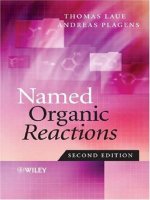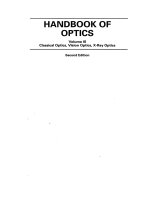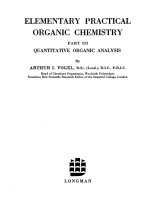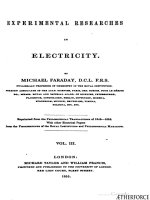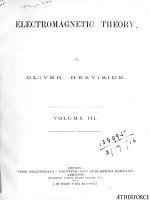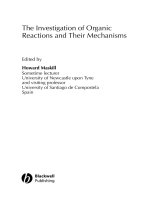Organic reactions vol 3 adams
Bạn đang xem bản rút gọn của tài liệu. Xem và tải ngay bản đầy đủ của tài liệu tại đây (5.28 MB, 466 trang )
Organic Reactions
VOLUME III
EDITORIAL
BOARD
ROGER ADAMS, Editor-in-Chief
WERNER E. BACHMANN
JOHN R. JOHNSON
LOUIS F. FIESER
H. R. SNYDER
ASSOCIATE
EDITORS
MARVIN CARMACK
PETER A. S. SMITH
H. E. CARTER
C. M. SUTER
W. E. HANFORD
EVERETT S. WALLIS
CHARLES C. PRICE
HANS WOLFF
JOHN L. WOOD
NEW YORK
JOHN WILEY & SONS, INC.
LONDON:
CHAPMAN & HALL, LIMITED
COPYRIGHT, 1946
BY
ROQEE ADAMS
All Rights Reserved
This book or any part thereof must not
be reproduced in any form without
the written permission of the publisher.
THIRD PRINTING, AUGUST, 1947
PRINTED IN THE UNITED STATES OP AMERICA
PREFACE TO THE SERIES
In the course of nearly every program of research in organic chemistry
the investigator finds it necessary to Use several of the better-known
synthetic reactions. To discover the optimum conditions for the application of even the most familiar one to a compound not previously
subjected to the reaction often requires an extensive search of the literature; even then a series of experiments may be necessary. When the
results of the investigation are published, the synthesis, which may have
required months of work, is usually described without comment. The
background of knowledge and experience gained in the literature search
and experimentation is "thus lost to those who subsequently have occasion to apply the general method. The student of preparative organic ,
chemistry faces similar difficulties. The textbooks and laboratory
manuals furnish numerous examples of the application of various syntheses, but only rarely do they convey an accurate conception of the
scope and usefulness of the processes.
For many years American organic chemists have discussed these
problems. The plan of compiling critical discussions of the more important reactions thus was evolved. The volumes of Organic Reactions
are collections of about twelve, chapters, each devoted to a single reaction, or a definite phase of a reaction, of wide applicability. The authors
have had experience with the processes surveyed. The subjects are
presented from the preparative viewpoint, and particular attention
is given to limitations, interfering influences, effects of structure, and
the selection of experimental techniques. Each chapter includes several detailed procedures illustrating the significant modifications of
the method. Most of these procedures have been found satisfactory
by the author or one of the editors, but unlike those in Organic Syntheses they have not been subjected to careful testing in two or more
laboratories. When all known examples of the reaction are not mentioned in the text, tables are given to list compounds which have been
prepared by or subjected to the reaction. Every effort has been made
to include in the tables all such compounds and references; however,
because of the very nature of the reactions discussed and their frequent
use as one of the several steps of syntheses in which not all of the intermediates have been isolated, some instances may well have been missed.
v
vi
PEEFACE TO THE SERIES
Nevertheless, the investigator will be able to use the tables and their
accompanying bibliographies in place of most or all of the literature
search so often required.
Because of the systematic arrangement of the material in the chapters
and the entries in the tables, users of the books will be able to find information desired by reference to the table of contents of the appropriate
chapter. In the interest of economy the entries in the indices have been
kept to a minimum, and, in particular, the compounds listed in the
tables are not repeated in the indices.
The success of this publication, which will appear periodically in
volumes of about twelve chapters, depends upon the cooperation of
organic chemists and their willingness to devote time and effort to the
preparation of the chapters. They have manifested their interest already
by the almost unanimous acceptance of invitations to contribute to the
work. The editors will welcome their continued interest' and their
suggestions for improvements in Organic Reactions.
CONTENTS
CHAPTER
PAGE
1. T H E ALKYLATION OF AROMATIC COMPOUNDS BY THE FBIEDEL-CRAFTS
M E T H O D — C h a r l e s C. Price
1
2. T H E W I L L G E R O D T R E A C T I O N — M a r v i n Carmack
a n d M. A. Spielman
3. P R E P A R A T I O N O F K E T E N E S AND K E T E N E D I M E R S — W . E. Hanford
. . .
a n d John
C. Sauer
4. DIRECT SULFONATION OF AROMATIC HYDROCARBONS AND THEIR HALOGEN
,
DERIVATIVES—C. M. Suter and Arthur W. Western
5. AZLACTONES—H. E. Carter
83
108
141
198
6. SUBSTITUTION AND ADDITION REACTIONS OF THIOCTANOGEN—John L. Wood 240
7. THE HOFMANN REACTION—Everett S. Wallis and John F. Lane
267
8. THE SCHMIDT REACTION—Hans Wolff
307
9. THE CURTIUS REACTION—Peter A. S. Smith
337
INDEX
451
vu
SUBJECTS OF PREVIOUS VOLUMES
VOLUME
AcETOACETIC ESTEE CONDENSATION AND RELATED REACTIONS
I
ALIPHATIC FLUORINE COMPOUNDS
II
AMINATION OF HETEROCYCLIC BASES
I
ARNDT-EISTERT REACTION
I
AROMATIC ARSONIC AND ARSINIC ACIDS
II
BlAETLS
II
BUCHERER REACTION
,
I
CANNIZZARO REACTION
II
CHLOROMETHYLATION OF AROMATIC COMPOUNDS
CLAISBN REARRANGEMENT
.
I
,
CLEMMENSEN REDUCTION
CYCLIC KETONES
II
.
I
II
ELBS REACTION
I
FRIES REACTION
I
JACOBSEN REACTION
I
MANNICH REACTION . . . . ' .
I
PERIODIC ACID OXIDATION
PERKIN REACTION AND RELATED REACTIONS
REDUCTION WITH ALUMINUM ALKOXIDBS
REFORMATSKY REACTION
II
I
II
I
REPLACEMENT OF AROMATIC PRIMARY AMINO GROUP BY HYDROGEN
II
RESOLUTION OF ALCOHOLS
II
CHAPTER 1
THE ALKYLATION OF AROMATIC COMPOUNDS BY THE
FRIEDEL-CRAFTS METHOD
CHARLES C.
PRICE
University of Illinois
CONTENTS
PAGE
2
INTBODUCTION
SCOPE AND LIMITATIONS
Activity of Catalysts
Alkylating Agents
Aromatic Compounds
Rearrangements of Alkyl Groups
Orientation in Alkylation
Identification
Related Reactions
Limitations
Other Methods of Alkylation
2
2
4
5
6
8
10
12
13
14
;
EXPERIMENTAL DIRECTIONS
16 '
Selection of Experimental Conditions
Triethylbenzene
<-Butylbenzene
|8-Cyclohexylnaphthalene
2,4,6-Triisopropylphenol
TABULATION OF EXPERIMENTAL RESULTS
16
16
17
18
18
.
19
TABLE
I. Reaction of Benzene with Aluminum Chloride
II. Alkylation of.Benzene
III. Alkylation of Halogenated Benzene Deriratives
IV. Alkylation of Toluene
V. Alkylation of Various Alkylbenzenes
VI. Alkylation of Tetralin
VII. Alkylation of Naphthalene . .
VIII. Alkylation of Miscellaneous Polynuclear Aromatic Compounds . . .
IX: Alkylation of Phenol
X. Alkylation of Various Phenols and Phenolic Ethers
X L Alkylation of Polyhydric Phenols
' X I I . Alkylation of Miscellaneous Aldehydes, Acids, and Quinones . . . .
X I I I . Alkylation of Aniline
XIV. Alkylation of Miscellaneous Aromatic Amines
XV. Alkylation of Heterocyclic Aromatic Compounds
1
21
22
44
45
48
52
53
56
58
65
69
72
73 •
74
76
2
ORGANIC REACTIONS
INTRODUCTION
Since the discovery by Friedel and Crafts' that aluminum chloride
catalyzes the condensation of alkyl and acyl halides with various
aromatic compounds to effect substitution of an alkyl or acyl group
for one or more hydrogen atoms of the aromatic compound, this reaction
has been greatly extended in scope with respect to alkylating or acylating agents and catalysts. The use of aluminum chloride as a catalyst
for such condensations has been considered in detail by Thomas,2 and
certain aspects of the reaction have been treated in an earlier volume of
this series.3 The present discussion is limited to the direct introduction
of alkyl, cycloalkyl, or aralkyl residues containing no functional groups
into various aromatic compounds under the influence of such catalysts as
AICI3, FeCl3, SbCl5, BF 3 , ZnCl2, TiCl4, HF, H2SO4, H 3 PO 4 , and P 2 O 5 .
The alkylating agents include olefins, highly strained cycloparaffins,
polyalkylbenzenes, alkyl halides, alcohols, ethers, and esters of organic
and inorganic acids. The aromatic compound may be a hydrocarbon, an
aryl chloride or bromide, a mono- or poly-hydric phenol or its ether, an
aromatic amine, an aldehyde, an acid, a quinone, or certain derivatives
of heterocyclic aromatic compounds such as furfural or thiophene.
The Friedel-Crafts process is frequently the most useful method for
the introduction of an alkyl group. The reaction is capable of many practical applications, and a large number of patents have appeared on the
preparation of alkyl derivatives of various aromatic compounds such as
xylene,4 naphthalene, and phenols. Patents have covered the utilization of such alkylating agents as the olefins derived from cracking, the
mixtures prepared by chlorination of petroleum fractions,6 and various
naturally occurring waxy esters.6 The most important application is
the synthesis of ethylbenzene from ethylene and benzene.
SCOPE AND LIMITATIONS
Activity of Catalysts. Very little work has been done on the direct
comparison of the relative efficacy of the catalysts used in the Friedel1
Friedel and Crafts, Compt. rend., 84, 1392, 14S0 (1877).
Thomas, "Anhydrous Aluminum Chloride in Organic Chemistry," American Chemioal Society Monograph 87, Reinhold Publishing Corp., New York, N. Y., 1941.
8
(a) Blatt, Organic Reactions, I, "The Fries Rearrangement"; (6) Fuson, ibid., "Chloromethylation of Aromatic Compounds.""
* Akt.-Ges. f. Anilinf., Ger. pat., 184,230 [Chem. Zentr., II, 366 (1907)].
'Thomas (to Sharpies Solvents Corp.), U. S. pat., 2,072,061 [C. A., 31, 2613 (1937)].
Wiggins, Hunter, and Nash. J. Inst. Petroleum, 26, 129 (1940).
•Robinson (to National Aniline and Chemical Co.), V. S. pat., 2,061,593 [C. A.,
31, 785 (1937)].
2
FRIEDEL-CRAFTS METHOD
3
Crafts reaction. The catalytic activity for various metal chlorides in the
condensation of toluene with acetyl chloride 7 is in the order A1C13 >
SbCl6 > FeCl 3 > TeCl 2 > SnCl 4 > TiCl 4 > TeCl 4 > BiCl 3 > ZnCl 2 .
The effect of catalysts for the Friedel-Crafts reaction in promoting the
racemization of a-phenylethyl chloride,8 which should parallel their
effect in catalyzing alkylation, 9 is in the order SbCls > SnCU >
BCI3 > ZnCl2 > HgCl 2 .
O6X15
V
. /
CH3
\
CHCl + MClx *±
CH+[MCl x + i]/
CH3
Hydrogen chloride, lithium chloride, and tetramethylammonium chloride are ineffective as catalysts for both racemization and alkylation. ^
No direct comparison of the acidic catalysts has been made, although
the order appears to be H F > H 2 SO 4 > P2C>5 > H 3 PO 4 . In general, a
direct comparison of the metal halides with the acids is limited by the
fact that the activity varies to some extent with the alkylating agent
selected. Sulfuric and phosphoric acids are usually more effective for
olefins or alcohols than for alkyl halides. For example, allyl chloride and
allyl alcohol condense principally at the double bond in the presence of
sulfuric acid,10 whereas in the presence of boron fluoride,11 ferric chloride,12 or zinc chloride I2 these substances react chiefly to form the allyl
derivative. Aluminum chloride causes condensation at both functional
'groups.12
I t is of interest to note that in several instances the effect of a catalyst
such as aluminum chloride or boron fluoride is enhanced by the presence
of an acidic "assistant." Alkylation by olefins with aluminum chloride
as a catalyst is favored by the presence of anhydrous hydrogen chloride,13 and the condensation of primary alcohols with benzene using
boron fluoride is possible only with the aid of an assistant such as phosr
phoric anhydride, benzenesulfonic acid, or sulfuric acid.14 I t has been
found also that chlorides of tin, silicon, or titanium increase the catalytic
activity of aluminum chloride, whereas ferric chloride decreases the
7
Dermer, Wilson, Johnson, and Dermer, / . Am. Chem. Soc., 63, 2881 (1941).
'Bodendorf and Bohme, Ann., 516, 1 (1935).
'Price, Chem. Revs., 29,37.(1941):
>
10
Iruffault, Compt. rend., 202, 1286 (1936); see also Niederl, Smith, and McGreal,
J. Am. Chem. Soc, 53, 3390 (1931); Smith and Niederl, ibid., 66,4151 (1933).
11
McKenna and Sowa, / . Am. Chem. Soc, 59, 470 (1937).
...." Niaetzesou and Isacescu, Ber., 66, 1100 (1933).
13
Berry and Reid, J. Am. Chem. Soc, 49, 3142 (1927).
"Toussaint and Hennion, J. Am. Chem. Soc, 62, 1145 (194Q), .. •„ .
:
ORGANIC REACTIONS
16
activity. Limited amounts of water frequently increase the effectiveness of boron fluoride or hydrogen fluoride.
Alkylating Agents. The ease of alkylation by means of a reagent
RX is dependent not only on the nature of X but also on the structure of
the group R. Structural factors in the alkyl group promoting the polarization of RX in the sense R + X~ facilitate alkylation.16
RX + Cat -> R+(X-Cat)-
Thus, with halides, alcohols, ethers, and esters, alkylation proceeds
most readily for tertiary or benzyl types, less readily for secondary
types, still less readily for primary types, and least readily for methyl.17
It is therefore generally necessary to use increasingly vigorous catalysts
or conditions to introduce the alkyl groups in the above sequence. For
example, reactive halides like benzyl chloride will' react with benzene in
the presence of traces of such a weak catalyst as zinc chloride, whereas an
inert halide like methyl chloride requires a considerable quantity of a
powerful catalyst such as aluminum chloride.
The relative reactivity of the alkyl halides is also conditioned by the
halogen atom. For aluminum chloride-catalyzed alkylations with either
n-butyl or <-butyl halides,18 the order of activity is F > Cl > Br > I.1*
This same order of reactivity has been found for hydrogen fluoridecatalyzed alkylation of benzene with cyclohexyl and s-octyl halides.20
The order of reactivity of the halides is thus the reverse of the normal
order.
Of the wide variety of alkylating agents which have been reported, the
alkyl halides, olefins, and alcohols are by far the most useful. Aluminum
chloride is an effective catalyst for all three classes. With halides and
olefins, it is required in only catalytic amounts; but with alcohols con15
Ott and Brugger, Z. Elektrochem., 46, 105 (1940).
For reviews summarizing the evidence on the mechanism of the Friedel-Crafts reaction see Calloway, Chem. Revs., 17, 327 (1935); Nightingale, ibid., 25, 329 (1939); Price,
ibid., 29, 37 (1941).
17
This same order of activity holds for the ease of migration and displacement of alkyl
groups already attached to the aromatic nucleus.
18
Calloway, J. Am. Chem. Soc., 59, 1474 (1937).
18
Calloway (see reference 18) made the interesting observation that the ease of acylation
with acyl halides is in the reverse order.
"> Simons and Bassler, J. Am. Chem. Soc., 63,88(5 (1941).
18
FRIEDEL-CRAFTS METHOD
5
siderably larger quantities are necessary because of the reaction of the
aluminum chloride with the alcohol. (See the article by Norris and
Sturgis cited on p. 8, reference 30.)
C2HB0H + A1C1,
C2H6C1 + A1OC1 - ^
> C2H6OH-A1C13
C2HBOAiCl2 + HC1
Although boron fluoride or hydrogen fluoride will catalyze alkylation
by means of alkyl halides, these catalysts are much more effective and
useful with olefins or alcohols. Reactions carried out with either of these
catalysts are distinguished by the lack of colored and resinous byproducts which so generally accompany the use of aluminum chloride.
Ethers and esters have not been widely applied in syntheses by the
Friedel-Crafts reaction, chiefly because they offer no particular advantage over the alcohols. In fact, with esters of organic acids and
aluminum chloride as catalyst, a disadvantage is the simultaneous
acylation. which may occur. However, the synthesis of toluene in 60%
yield from benzene, methyl sulfate, and aluminum chloride represents
the most successful procedure for the monomethylation of benzene
(see p. 22).
The use of cyclopropane as an alkylating agent has yielded n-propylbenzene in 65% yield (see references 26 and 36 on p. 8), but other syntheses, such as the preparation from n-propyl alcohol in 52% yield
(see references 26 and 27, p. 8), are probably of more practical application.
CH2
Aromatic Compounds. One characteristic feature of alkylation by the
Friedel-Crafts procedure is that alkyl substituents in the aromatic ring
markedly increase the ease of alkylation. Thus, there is a general
tendency for the formation of considerable amounts of polyalkyl derivatives.
An interesting observation in this connection is that the structure of
the alkyl group is an important factor regulating the maximum number
of alkyl groups which can be introduced into the benzene ring by the
Friedel-Crafts method. (See reference 36, p. 8.) Although all six of
the hydrogen atoms of benzene can be replaced by methyl, ethyl, or
n-propyl groups, only four can be replaced by isopropyl groups, and,
6'
ORGANIC REACTIONS
although three have been replaced by £-butyI groups, the usual and
principal product in this instance is the p-di-i-butyl derivative.
C2H6
CH(CH3)2
C(CH3)3
(CH3)2CH
C(CH3)3
The effect of a hydroxyl or an alkoxyl group on the ease of alkylation
is complex. In some instances, the effect appears to be an activation.
For example, although nitrobenzene has not been alkylated, o-nitroanisole has been converted into the isopropyl derivative in good yield.
j>CH(CH3)2
O2N ~
(84%)
The normal activating influence of the hydroxyl or alkoxyl group is
counterbalanced by the tendency for the catalyst to coordinate with the
oxygen atom.
F
C6H6—O: + B:F -» C6HB—0—>BF3
CH3
F
CH3
This process not only decreases the activity of the catalyst but also tends
to nullify the activating effect of the oxygen atom. This general effect
is still more pronounced for aromatic amines, so that alkylation of these
substances has found only very limited application.
Rearrangements of Alkyl Groups. One factor involved in alkylation
by the Friedel-Crafts method which has led to many conflicting and
erroneous reports in the literature is the tendency for rearrangements of
the alkyl group to occur during alkylation. The exact nature of the
influence involved in these rearrangements is still not entirely clear.
In general, the tendency of the rearrangements is in the direction: primary
—> secondary —> tertiary. Usually the rearrangements involve only the
migration of hydrogen atoms in the alkyl group rather than a rearrangement of ,the carbon skeleton.
The first observation of such a rearrangement was made by Gustavson21 only a year after the announcement of the Friedel-Crafts
reaction. He found that w-propyl and isopropyl bromides react with
21
Gustavson, Ber., 11, 1251 (1878).
FRIEDEL-CRAFTS METHOD
7
benzene in the presence of aluminum chloride to form the same substance, isopropylbenzene (cumene). "The discovery that n-propyl
bromide is isomerized to isopropyl bromide in the presence of aluminum chloride offers an explanation for this observation.22
CeHe -f- w-C3H7Br>
WO-C3H7C6H6
C6H6 +
MO-C3H7B:
n-C3H7Br
tso-C3H7Br
Since such rearrangements may be represented as occurring by intermediate formation of an olefin, it has been suggested that olefins are
involved as intermediates in the alkylations.11' n
w-C3H7Br - ^ - >
[C 3 H 6 ] - ^ - > wo-C 3 H 7 C 6 H 8
lHBr
I
Aids
'
tso-C3H7Br
The general theory of molecular rearrangements as outlined by Whitmore 23groups during alkylation.9
CH3CH2CH2C1 + AlClg =± CH3CH2CH-+A1C14'
i
(CH3)2CH+
CH 3
It is by no means necessary to suppose that an olefin is formed as an
intermediate in all alkylations. For example, benzyl alcohol and benzhydrol are particularly effective alkylating agents, but the intermediate
formation of an olefin is impossible. Furthermore, under many conditions alkylation may proceed without rearrangement. It has been found
that n.-propyl chloride in ike cold will react with benzene in the presence
2S
Kekul6 and Sohrotter, Bull. soc. chim., [2] 34, 485 (1879).
MoKenna and Sowa, J. Am. Chem. Soc., 59,1204 (1937).
2sa Whitmore, J. Am. Chem. Soc., 54, 3274 (1932).
23
8
ORGANIC REACTIONS
of aluminum chloride to give chiefly n-propylbenzene whereas at higher
temperatures the product is chiefay isopropylbenzene.24'26'26
The catalyst may also influence the fate of the alkyl group. Normal
alcohols, for example, usually alkylate without rearrangemerft in the
presence of aluminum chloride,26'27'28 but rearrangement does occur
when sulfuric acid 26> 29 or boron fluoride u> w is used as a catalyst.
Under vigorous conditions changes even more extensive than isomerization of the alkyl group can occur. Although benzene is alkylated
normally in good yield with t-butyl alcohol and aluminum chloride at
30°, the products at 80-95° are toluene, ethylbenzene, and isopropylbenzene.30 Alkylation with 2,4,4- or 2,3,3-trimethyl-2-pentanol can
proceed to yield both normal and degraded alkylation products, the
extent of degradation increasing with temperature.31 The alkylation of
methyl 2-furoate proceeds normally at the active 5-position, but the
alkylation of methyl 5-bromo-2-furoate at the inactive 4-position proceeds with .degradation of all alkyl groups with more than four carbon
atoms to give the 4-<-butyl derivative in every case.32' M Treatment of
paraffin hydrocarbons with benzene in the presence of aluminum chloride
leads to the formation of various alkylbenzenes by degradation of the
paraffin, a reaction which has been termed "destructive alkylation." M
Orientation in Alkylation. An additional factor complicating the usefulness of Friedel-Crafts alkylations is the orientation involved in the
introduction of more than one alkyl group.35'36 It was discovered at an
early date that alkylation with aluminum chloride and alkyl halides
yields considerable proportions of m-dialkylbenzenes, as well as the
expected o- and p-isomers. The relative extent of normal and abnormal
orientation has been found to be a function of the conditions of alkylation. In general, the more vigorous the conditions with respect to the
activity of the catalyst or the alkylating agent or the severity of the
time and temperature factors, the greater is the tendency for the forma** Heise, Ber., 24, 7^8 (1891).
86
Konowalow, J. Buss. Phys.-Chem. Soc., 27, 457 (1895).
26
Ipatieff, Pines, and Schmerling, J. Org. Chem., 5, 253 (1940).
"Tsukervanik and Vikhrova, J. Gen. Chem. U.S.S.R., 7, 632 (1937) [C. A., 31, 5779
(1937)].
28
Bowden, J. Am. Chem. Soc, 60, 645 (1938).
M
Meyer and Bernhauer, Monatsh., 53 and 54, 721 (1929).
30
Norris and Sturgis, / . Am. Chem. Soc., 61, 1413 (1939).
11
Huston, Guile, Sculati, and Wasson, J. Org. Chem., 6, 252 (1941).
82
Gilman and BuHner, J. Am. Chem. Soc, 57, 909 (1935).
"Gilman and Turok, J. Am. Chem. Soc, 61, 473 (1939).
84
Grosse, Mavity, and Ipatieff, J. Org. Chem., 3, 137 (1938).
36
See Ingold, Lapworth, Rothstein, and Ward, J. Chem. Soc, 1931, 1959; Bird and
Ingold, ibid., 1938, 918.
3
« Grosse and Ipatieff, J. Org. Chem., 2, 447 (1937).
FRIEDEL-CBAFTS METHOD
9
tion of the abnormal m-derivatives. Thus, alkylation catalyzed by
aluminum chloride, the most active catalyst, leads to large proportions
of m-dialkylbenzenes, particularly with large amounts of catalyst at
high temperatures or for long reaction times. Alkylations catalyzed
with boron fluoride, sulfuric acid, ferric chloride, and most other catalysts yield chiefly the normal p-dialkylbenzenes.
CH3
CH3
BX
ROH
BF,
Naphthalene likewise yields two dialkyl derivatives; the principal
dialkylation product from the reaction of naphthalene and cyclohexanol or cyclohexene with aluminum chloride as the catalyst has been
shown to be 2,6-dicyclohexylnaphthalene,36boron fluoride, 1,4-dicyclohexylnaphthalene is obtained.36*
+ CHuOH
A1C1,
A similar situation obtains in the trialkylation of benzene, the 1,2,4trialkyl derivative being formed only under mild conditions, the 1,3,5isomer under more vigorous conditions.37 It has been shown that the
1,2,4-trialkyl derivatives will, in many instances, rearrange to the 1,3,5isomer under the influence of aluminum chloride.38'39'40-41-42
3a
' Price and Tomisek, J. Am. Chern. Soc., 65, 439 (1943).
Price, Shafer, Huber, and Bernstein, J. Org. Chem., 7, 517 (1942).
87
Norris and Kubinstein, / . Am. Chem. Soc, 61, 1163 (1939).
88
Baddeley and Kenner, J. Chem. Soc, 1935, 303.
89
Nightingale and Smith, J. Am. Chem. Soc, 61, 101 (1939).
40
Smith and Perry, J. Am. Chem. Soc, 61, 1411 (1939).
41
Nightingale and Carton, J. Am. Chem. Soc, 62, 280 (1940).
41
Nightingale, Taylor, and Smelser, J. Am. Chem. Soc, 63, 258 (1941).
866
10
ORGANIC REACTIONS
Even in the alkylation of phenols and aromatic halides similar effects
on orientation have been observed. Thus, the ethylation of phenol with
ethanol and aluminum chloride yields the o- and p-derivatives,43 whereas
with ethyl ether as the alkylating agent at a higher temperature 3,5diethylphenol ** is obtained. Alkylation of chlorobenzene with ethanol
and aluminum chloride at 80-90° yields p-chloroethylbenzene,46 but with
ethylene at 100°, the principal product is the m-isomer.46
C2H5
Since alkylation by the Friedel-Crafts reaction has been demonstrated to be a reversible reaction,47'48'49 it has been suggested that the
various anomalous orientations can be explained on this basis. Jacobsen 60 was the first of many s«. *i. «. « to' point out that normal alkylation to form the 1,2,4-trialkyl derivative, followed by loss of the alkyl
group in the 1-position, might account for the anomalous formation of mdialkyl derivatives.
Identification. The many possibilities for the formation of isomeric or
anomalous products due to rearrangement, unusual orientation, or
degradation of alkyl groups during the Friedel-Crafts reaction, coupled
with the fact that the products are usually liquids, difficult to separate
and identify, frequently necessitate particular care in establishing the
structure and the purity of the products.64 The most effective method
43
Tsukervanik a n d Nazarova, J. Gen. Chem. U.S.S.R., 7, 623 (1937) [C. A . 3 1 , 5778
(1937)].
44
Jannasch a n d Rathjen, Ber., 32, 2391 (1899).
45
T s u k e r v a n i k , J. Gen. Chem. U.S.S.R., 8, 1512 (1938) [C. A . , 33, 4587 (1939)].
48
Istrati, Ann. chim., [6] 6, 3 9 5 (1885).
47
Boedtker, Bull. soc. chim., [3] 35, 834 (1906).
48
Boedtker and Halse, Bull. soc. chim., [4] 19, 447 (1916).
49
Woodward, Boreherdt, and Fuson,.J. Am. Chem. Soc, 56, 2103 (1934).
60
Jacobsen, Ber., 18, 342 (1885).
61
Anschiitz, Ann., 235, 177 (1886); Moyle and Smith, J. Org. Chem., 2, 114 (1937).
«-Schorger, J. Am. Chem. Soc., 39, 2671 (1917).
68
Price and Ciskowski, J. Am. Chem. Soc., 60, 2499 (1938).
"See Marvel and Himel, / . Am. Chem. Soc, 62, 1550 (1940), who found that the
aluminum chloride-catalyzed condensation of cyclohexyl chloride with bromobenzene
yielded a mixture of all three bromocyclohexylbenzenes.
FRIEDEL-CRAFTS METHOD
11
of establishing the orientation of the alkyl groups is oxidation to the
corresponding aromatic acids. This is sometimes difficult for the tertiary
groups, particularly (-butyl; for example, Jthe oxidation of p-di-£-butylbenzene with chromic acid yields 2,5-di-t-butylbenzoquinone as the
principal product. 66
0
(CH3)
and
(CH3)3C
The structure of the side chain may be established by a synthesis
that leaves no doubt about the structure of the product. Alkylbenzenes
containing primary alkyl groups may be prepared by Clemmensen
reduction of an aryl allsyl ketone, 89 ' 66 and those containing secondary
groups by reaction of an aryl alkyl ketone with a Grignard reagent
followed by dehydration and reduction. 67 A primary alkyl group attached to a benzene ring can be distinguished from a secondary or tertiary group by bromination in the presence of aluminum bromide; all
hydrogen atoms and secondary or tertiary alkyl groups attached to a
benzene ring are replaced by bromine under these conditions,-whereas
primary alkyl groups are not affected.68
wo-C3xi7CfiIi5
n-C3H7C6H6
^ CfiBrg ~r~ &0"C 3 H 7 Br ~p 5 H B r
5Br
' > n-C3H7C6Br6 + 5HBr
AlBr8
Identification of alkylated benzenes can be accomplished to some
degree by the physical properties, more definitely by preparation of a
solid derivative such as a sulfonamide, 29 - 69 - eo a diacetamino derivative, 600 or a picrate. 63 ' 59
66
Boedtker, Bull. soc chim., [3] 31, 969 (1904).
Gilman and Turck, J. Am. Chem. Soc, 61, 478 (1939); Martin, Organic Reactions, I,
"The Clemmensen Reduction."
67
Klages, Ber., 35, 3509 (1902).
68
Bodroux, Ann. chim,., [10] 11, 511 (1929); Hennion, J. Am. Chem. Soc., 66, 1801 (1944).
69
Shriner and Fuson, "Identification of Organic Compounds," John Wiley & Sons,
New York, 2nd ed., 1940.
60
Huntress and Autenrieth, J. Am. Chem. Soc, 63, 3446 (1941).
ma
Ipatieff and Schmerling, J. Am. Chem. Soc, 59,1056 (1937) ; 60,1476 (1938); see also
reference 42.
66
12
ORGANIC REACTIONS
Related Reactions. Many compounds containing more than one
carbon-halogen or carbon-oxygen bond, although beyond the scope of
this chapter (see p. 4), undergo stepwise reaction with aromatic
compounds to form, as intermediates, alkylating agents of the type
under consideration. For example, methylene chloride reacts with
benzene in the presence of aluminum chloride to yield diphenylmethane,
presumably through the intermediate formation of benzyl chloride.36
Other examples are noted in the following equations.
C 6 H 6 + CH 2 C1 2
[C 6 H 6 CH 2 C1]
C 6 H 6 + CH 2 O
[C 6 H 6 CH 2 OH]
(C 6 H 6 ) 2 CH 2
[(C 6 H 6 ) 2 CHC1]
(C 6 H 6 ) 3 CH
2C 6 H 6 + CHCI3
C 6 H 6 + C 6 H 6 CHO
C 6 H 6 + CH 2 C1CH 2 C1
[(C 6 H 6 ) 2 CHOH]
(C 6 H 6 ) 2 CH 2
AIC/I3
(C 6 H 6 ) 3 CH«i
[C 6 H 6 CH 2 CH 2 C1] ^ >
C6HBCH2CH2C6H6
AIC13
C6H6 + C H 2
CH2
[C 6 H B CH 2 CH 2 OH] ^%
C 6 H 5 CH 2 CH 2 C 6 H5 61 '« 2
AICI3
0
The reactions of aldehydes and ketones with phenols have been investigated extensively.
If the two groups in a molecule capable of condensing with the aromatic ring are properly situated, the reaction may yield a cyclic product,
a process which has been termed "cyclialkylation." 63
The condensations of halides, alcohols, and unsaturated compounds
containing a variety of other functional groups have been carried out
61
Schaarschmidt, Hermann, and Szemzo, Ber., 58, 1914 (1925).
Theimer, Abstracts, Division of Organic Chemistry, 99th Meeting of the American
Chemical Society, Cincinnati, Ohio, April, 1940, p. 42. Matui, J. Soc. Chem. Ind. Japan,
44, No. 2, 88 (1941).
63
Bruson and Kroeger, J. Am. Chem. Soc, 62, 36 (1940).
42
FRIEDEL-CRAFTS METHOD
13
M
successfully. Thus, nitrobenzyl alcohols and halides condense in the
normal manner, and the addition of a variety of aromatic compounds to
the double bonds in unsaturated ketones such as benzalacetophenone49
or, unsaturated acids such as cinnamic 66 or oleic acids 66 has been
reported.
Limitations. Two important factors which govern the application of
the Friedel-Crafts reaction are the activity of the aromatic compound
and the activity of the alkylating agent and catalyst. Thus if the
alkylating agent and catalyst are very reactive and the aromatic substrate is relatively inert, extensive degradationso'31> 32> 3S or polymerization 67 of the alkylating agent may occur. If the aromatic substrate is
very reactive toward the catalyst and the alkylating agent is relatively
inert, decomposition of the aromatic compound may take precedence
over alkylation. For example, naphthalene reacts in the presence of
aluminum chloride to form binaphthyls 68 and tetralin is degraded to
AlCls
2C,0H8
> H2 + (C10H7)s
benzene and a mixture of octahydroanthracene and octahydrophenanthrene through the intermediate formation of ^-(4-phenylbutyl)tetralin.69
Methylation of naphthalene and tetralin therefore can be accomplished only in very poor yields. Similarly such reactive heterocyclic
aromatic substances as furan and thiophene.have not been alkylated
successfully by the Friedel-Crafts method. Deactivation of the furan
nucleus by the carboxyl group of furoic acid, however, makes alkylation
by the Friedel-Crafts procedure feasible and useful (see Table XV,
p. 76).
61
Staedel, Ann., 283, 157 (1895).
Liebermann and Hartmann, Bee., 25, 957 (1892).
66
Stirton and Peterson, Ind. Eng. Ckem., 31, 856 (1939).
67
Truffault, Compt. rend., 202, 1286 (1936).
68
Homer, J. Chem. Soc, 91, 1108 (1907).
•• Barbot, Bvtt. soc. chim., [i] 47, 1314 (1930).
M
14
ORGANIC REACTIONS
The alkylation of anisole under the vigorous conditions necessary to
introduce an isopropyl group (aluminum chloride at 120-140°) leads
to extensive demethylation.43 Alkylation of phenol under many condiC6HBOCH3 + C3H7ok - ^ > C3H7C6H4OCH3 and C3H7C6H4OB
140
tions may produce ethers as well as nuclear alkylation products.91 Both
C6H6OH + C3H6 -> C3H7C6H4OH, C6H6OC3H7 and Cs
formation and splitting of ethers seems to be minimized by the use of
hydrogen fluoride as the catalyst for alkylation of phenol or its ethers.
Aluminum chloride has been used as a catalyst for the alkylation of
phenols or of acids, but it should be noted that these reagents frequently
react vigorously to yield aluminum salts of the phenols or acids. For this
reason boron fluoride, hydrogen fluoride, and sulfuric acid generally
have been used as catalysts for alkylation of such substances.
C6H6OH + A1C18 -> C6H6OA1C12 + HC1
ArCO2H + AlClg -> ArCO2AlCl2 + HC1
The reaction of bromo compounds is complicated by the possibility of
migration of the aromatically bound bromine atom in the presence of
aluminum chloride.64'70 Thus appreciable quantities of p-dibromobenzene are produced in aluminum chloride-catalyzed alkylations of
bromobenzene.
C6HBBr + RC1 A'C1' > RC6H4Br and p-C6H4Br2
Recently, alkylation of a few aromatic aldehydes and acids has also
been accomplished successfully.32' 71 Nitrobenzene is not alkylated under
Friedel-Crafts conditions; it is converted slowly to 0- and p-chloroaniline
in the presence of isobutyl chloride and aluminum chloride.72
Other Methods of Alkylation. A useful method for the preparation of
certain alkylated phenols is that devised by Claisen 73 and extended by a
number of investigators.74'76-76'77 The nuclear alkylation of phenols is
accomplished by treating the sodium phenoxide with an active halide of
70
Copisarow, J. Chem. Soc., 119, 4 4 2 (1921).
Calcott, 'Tinker, and Weinmayr, J. Am. Chem. Soc., 61, 1010 (1939).
72
Gilman, Burtner, Calloway, and Turck, J. Am. Chem. Soc., 57, 907 (1935).
73
Claisen, Ann., 442, 220 (1925); Ber., 58, 275 (1925); 59, 2344 (1926).
"Schorigin, Ber., 58, 2033 (1925); 59, 2506 (1926); Busch, Z. angew. Chem., 38, 1145
(1925); Ber., 60, 2243 (1927); van Alphen, Eec. trav. chim., 46, 287, 799 (1927).
76
Huston and Houk, J. Am. Chem. Soc., 54, 1506 (1932).
78
Huston and Lewis, / . Am. Chem. Soc, 53, 2379 (1931).
77
Huston, Swartout, and Wardwell, J. Am. Chem. Soc., 52, 4484 (1930).
71
FRIEDEL-CRAFTS METHOD
15
the allyl or benzyl type (or even i-butyl chloride 78) in an inert solvent
such as toluene. The alkylation of phenols by this procedure supplements the Friedel-Crafts method since the products by the Claisen
method are practically always the o-isomers whereas Friedel-Crafts
alkylation usually yields the p-isomer.73'75> 76-77 Another method for
the preparation of alkylated phenols, also due to Claisen, is the rearrangement of phenyl ethers, a reaction which is considered in detail
in another chapter.78"
One or two useful indirect methods have been reported for the introduction of methyl groups. Nuclear methylation of phenols has been
accomplished by the condensation of phenols with formaldehyde and
secondary amines,79 followed by hydrogenation of the intermediate
benzylamine.79"
(H)
ArOH + CH 2 O + R 2 NH -* R 2 NCH 2 Ar0H —->• R 2 NH + CHgArOH
A successful preparation of 1,2,3-trimethylbenzene (not available by
the Friedel-Crafts method) has been accomplished by use of the Tiffeneau rearrangement which occurs during the reaction of benzyl-type
Grignard reagents with formaldehyde. 80
CH2MgX
CH3
+ CH2O ->
CH3
C
A number of polyalkylbenzene derivatives not directly available by
the Friedel-Crafts procedure may be prepared by application of the
Jacobsen rearrangement.80"
The alkylation of aromatic nitro compounds and of quinones has been
accomplished by means of the radicals liberated by the decomposition
of tetravalent lead salts of organic acids or of acyl peroxides, or by the
electrolysis of sodium salts of organic acids.80*1
CH 3
78
Lewis, J. Am. Chem. Soc., 83, 329 (1903).
Tarbell, Organic Reactions, II, "The Claisen Rearrangement."
Blicke, Organic Reactions, I, "The Mannich Reaction."
na
Caldwell and Thompson, J. Am. Chem. Soc., 61, 2345 (1939).
80
Smith and Spillane, J. Am. Chem. Soc., 62, 2643 (1940).
SOa
Smith, Organic Reactions, I, "The Jacobsen Reaction,"
806
Fieser and Chang, J. Am. Chem. Soc., 64, 2043 (1942); Fieser, Clapp, and Daudt,
ibid., 2052; Fieser and Oxford, Md., 2060.
78a
n
16
ORGANIC REACTIONS
0
0
EXPERIMENTAL DIRECTIONS 81
Selection of Experimental Conditions. An examination of the tables
will suggest the most favorable experimental conditions for many particular alkylations. A few generalizations are evident. Owing to the
activation of the aromatic nucleus by the alkyl group, maximum conversion to the monoalkyl derivative is favored by the presence of a large
excess of the aromatic compound. To increase further the overall conversion to the monoalkyl derivative, the polyalkylated material from
one run may be recovered and added to the next. Because of mobility
of the alkyl groups, some are removed to another aromatic nucleus by
this process. The polyalkylated material thus actually may serve as the
alkylating agent.48
Orientation in di- or trialkylation may be regulated by controlling
the vigor of the reaction. Relatively mild catalysts, such as boron
fluoride (with an alcohol), hydrogen fluoride (with an olefin), or ferric
chloride (with an alkyl halide), may lead almost exclusively to p-dialkylation or 1,2,4-trialkylation. Under more vigorous conditions, as with
excess aluminum chloride at elevated temperatures, the m-dialkyl or
sym-trialkyl derivative predominates.
The quantity of catalyst necessary may vary considerably. Only
catalytic amounts of aluminum chloride are required when olefins or
alkyl halides are the alkylating agents. • With alcohols or their derivatives, much larger amounts of catalyst are required, owing to inactivation by reaction with the alcohol or with the water formed during the
reaction. With hydrogen fluoride it is universal practice to use a large
excess of catalyst, so much so that it is actually the solvent medium for
the reaction.
1. sym-Trieihylbenzene.w A 5-1. three-necked flask surrounded by a
•
81
Since an excellent preparation utilizing sulfuric acid, that of cyclohexylbenzene from
cyclohexene and benzene, has been described in detail in Organic Syntheses {Coll. Vol, 2, 151,
John Wiley & Sons, New York, 1943), no experimental directions illustrating the technique
employed with this useful catalyst have been included in this section.
82
This is essentially the procedure of Norris and Rubinstein (reference 37). Norris and
Ingraham [/. Am. Chem. Spc., 60, 1421 (1938)] have prepared the same compound in
65-70% yield with ethanol as the alkylating agent. In this case, a considerably larger
ratio of aluminum chloride is required.
FRIEDEL-CRAFTS METHOD
17
»
tub of ice-salt mixture is fitted with (1) an efficient stirrer sealed with
a mercury seal or a tight-fitting piece of rubber pressure tubing lubricated with mineral oil (not glycerol), (2) a long reflux condenser with
a glass outlet tube leading to a hood or an efficient apparatus for absorbing hydrogen halide, (3) a thermometer well (containing ethanol), and
(4) a 500-cc. separatory funnel.
Four pounds w (1815 g., 6.8 moles) of anhydrous,aluminum chloride
is added to the flask and is moistened with 750-1000 cc. of dry ethyl
bromide. The stirrer is started, and, when the temperature reaches
— 10°, addition of dry benzene (530 g., 604 cc, 6.8 moles) through the
separatory funnel is carried out at such a rate that the temperature stays
below —5° (about two and a quarter hours is necessary). The rapid
current of hydrogen halide evolved carries some of the ethyl bromide out
through the condenser.
After the benzene has been added the remainder of a total of 2425 g.
(1695 cc, 21.8 moles) of ethyl bromide is added over a period of about
one and a quarter hours. The ice is then removed from the cooling bath
and stirring is continued overnight while the mixture gradually warms
to room temperature. The bath is then removed and stirring is continued for another twenty-four hours, when evolution of hydrogen halide
has ceased.
The reaction mixture is poured into a large separatory funnel from
which it is added, in a fine stream and with vigorous stirring, to 10 kg.
of ice and 300 cc. of concentrated hydrochloric acid in a large crock.
This operation should be performed in a good hood. When hydrolysis is
complete, the major portion of the lower water layer is removed by
siphoning and the reaction mixture is filtered to remove a black solid
which impedes. separation of the layers during washing. The organic
layer is then separated and washed with dilute hydrochloric acid, twice
with water, with 5% aqueous sodium hydroxide, and twice with water.
After drying over calcium chloride, the product is distilled through an
efficient fractionating column. The triethylbenzene (943-962 g., 8687%) boils at 72.5-75°/3 mm. or 215-216°/760 mm.; nf>° 1.49551.4968.84
2. trButylbenzene.** A mixture of 105 g. (1.35 moles) of benzene and
88
This preparation may be run as efficiently on a much smaller scale, if desired.
Norria and Ingraham (reference 82) give directions for further purification of the
sjfln-triethylbenzene by means of sulfonation; b.p. 214.8° (75S.1 mm.); njj'1 1.4956.
85
These directions are those of Nightingale, Taylor, and Smelser (reference 42). A smaller
yield (50-55%) is obtained with aluminum chloride as a catalyst (Fieser, "Experiments in
Organic Chemistry," 2nd ed.. D. C. Heath and Co., New York, 1941, p. 179). The same
situation holds for f-butyl alcohol, ferric chloride giving better yields than aluminum chloride [Potts and Dodson, J. Am. Chem. Soc., 61, 2553 (1939)].
84
18
ORGANIC REACTIONS
t
12 g. (0.07 mole) of anhydrous ferric chloride (in a flask fitted with a condenser and a trap to absorb hydrogen chloride 86°) is cooled to 10°, and
25 g. (0.27 mole) of i-butyl chloride is added. As the mixture is slowly
warmed to about 25°, evolution of hydrogen chloride proceeds smoothly.
When the evolution of hydrogen chloride ceases, the reaction mixture is
washed with dilute hydrochloric acid and with water, dried, and fractionally distilled. The Z-butylbenzene (29 g., 80%) boils at 167-170°.
3. fi-Cyclohexylnaphthalene.*6 Boron fluoride 87 is passed through an
empty 250-cc. suction filter flask (as a safety trap) and is then bubbled
through a suspension of 50 g. (0.39 mole) of naphthalene in 40 cc. (38 g.,
0.47 mole) of cyclohexanol in a 500-cc. flask at room temperature 87°
until two liquid layers separate in the reaction mixture (fifteen to thirty
minutes). 88
The reaction flask is fitted with an outlet tube 89 leading to the top of
a vertical meter-long glass tube through which a stream of water is
passed; this apparatus serves to absorb the excess boron fluoride.
After standing for about an hour, the reaction mixture is separated
and the upper layer washed 90 with dilute alkali and with water. After
drying, the mixture is fractionally distilled under diminished pressure in
a modified Claisen flask, 52 g. (63%) of /?-cyclohexylnaphthalene
(b.p. 190-195715 mm.; nf? 1.5973; d£g 1.020) is obtained. The
product may be characterized by preparation of the picrate, 59 m.p.
1OO0.63-B8
4. %,4,6-Triisopropylphenol.91 About 800 g. of liquid hydrogen
860
Org. Syntheses, Coll. Vol. 2, 4, John Wiley & Sons, New York, 1943.
These directions are based on the general procedure described by McKenna and
Sowa (reference 11) for benzene and adapted to naphthalene by Price and Ciskowski (reference 53). It is useful for alkylation by means of secondary, tertiary, and benzyl-type alcohols. Toussaint and Hennion (reference 14) have found that by addition of an "assistant,"
such as phosphoric anhydride or benzenesulfonic acid, the procedure may be extended to
many primary alcohols.
87
Cylinders of the compressed gas can be purchased from the Harshaw Chemical Co.,
Cleveland, Ohio.
870
If the reaction mixture is cooled to 0°, the boron fluoride dissolves without reacting
until finally the reaction occurs with nearly explosive violence.
88
Glass apparatus is satisfactory although it has been found that, after repeated use,
Pyrex flasks used for the condensation become appreciably etched.
89
As much as possible of the tubing for handling boron fluoride should be glass, since
rubber soon hardens on contact with the gas.
80
Occasionally, naphthalene may crystallize during the washing. If so, it should be
separated by nitration.
91
These are the directions of Calcott, Tinker, and Weinmayr (reference 71). Hydrogen
fluoride appears to be particularly suitable for nuclear alkylation of phenols and amines,
since there was no detectable alkylation of the hydroxyl or amino group, a side reaction
which occurs to an appreciable extent with such catalysts as aluminum chloride (see reference 43) and boron fluoride [Sowa, Hinton, and Nieuwland, J. Am. Chem. Soc, 64, 3694
(1932)].
88
FRIEDEL-CRAFTS METHOD
19
fluoride w is placed in a 2- to 3-1. copper, stainless steel, or nickel vessel
(such as a beaker made of the metal) which is thoroughly cooled with an
ice or ice-salt bath. The reaction vessel should be fitted with a cover
perforated for a mechanical stirrer, a thermometer well, and an opening
for the addition of reagents. The reaction mixture is kept below 8°
while a solution of 140 g. (1.49 moles) of phenol in 515 cc. (405 g.,
6.75 moles) of isopropyl alcohol is added from a separatory funnel over a
period of three hours. The reaction mixture is then allowed to stand in
a hood at room temperature for sixteen hours, after which time it is
poured onto a large excess of ice (in a Pyrex beaker). Benzene is added;
the organic layer is separated and washed with water, with dilute sodium
bicarbonate, and again with water. The mixture is then dried and, after
evaporation of the benzene, distilled under diminished pressure. 2,4,6Triisopropylphenol (310 g., 95%) boils at 125°/7 mm.
TABULATION OF EXPERIMENTAL RESULTS
The summary of experimental results of the alkylation of various
aromatic compounds has been divided into tables on the basis of the
aromatic compound alkylated. These tables summarize the reagents
and catalysts used for the various alkylations and, when available, such
details as moles of reactants, solvent, temperature, time of reaction,
products, and yields.
In each table the alkylations have been arranged in order according to
the increasing number of carbon atoms in the alkyl group. These groups
are further subdivided in order on the basis of decreasing number of
hydrogen atoms; thus, examples of the introduction of the allyl group
follow those of the propyl, and examples of the introduction of the cyclohexyl group follow those of the hexyl. For the introduction of any particular alkyl group, the arrangement is based on the alkylating agent.
Hydrocarbons, such as olefins, are first, then alkyl halides, followed by
alcohols and finally alcohol derivatives, such as ethers and esters of
organic and inorganic acids.
92
Since hydrogen fluoride boils at 20°, the liquid can be very readily withdrawn from
cooled inverted cylinders with a length of copper tubing leading from the valve of the
oylinder to a copper beaker or flask immersed in an ice bath. If the liquid is kept cold
(10° or below), it can be handled quite easily. The reactions should be carried out in a
hood, however, and all handling of the liquid should be done with long, heavy rubber
gloves as a precaution against accidental contact with the liquid.
